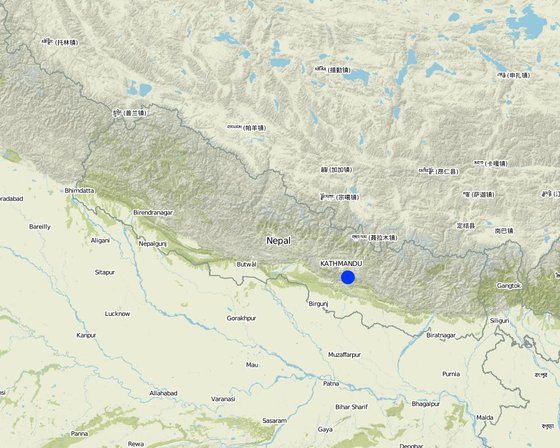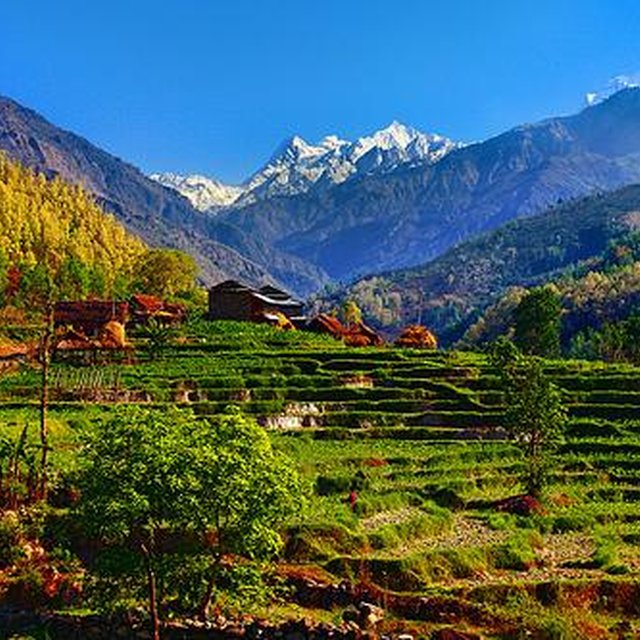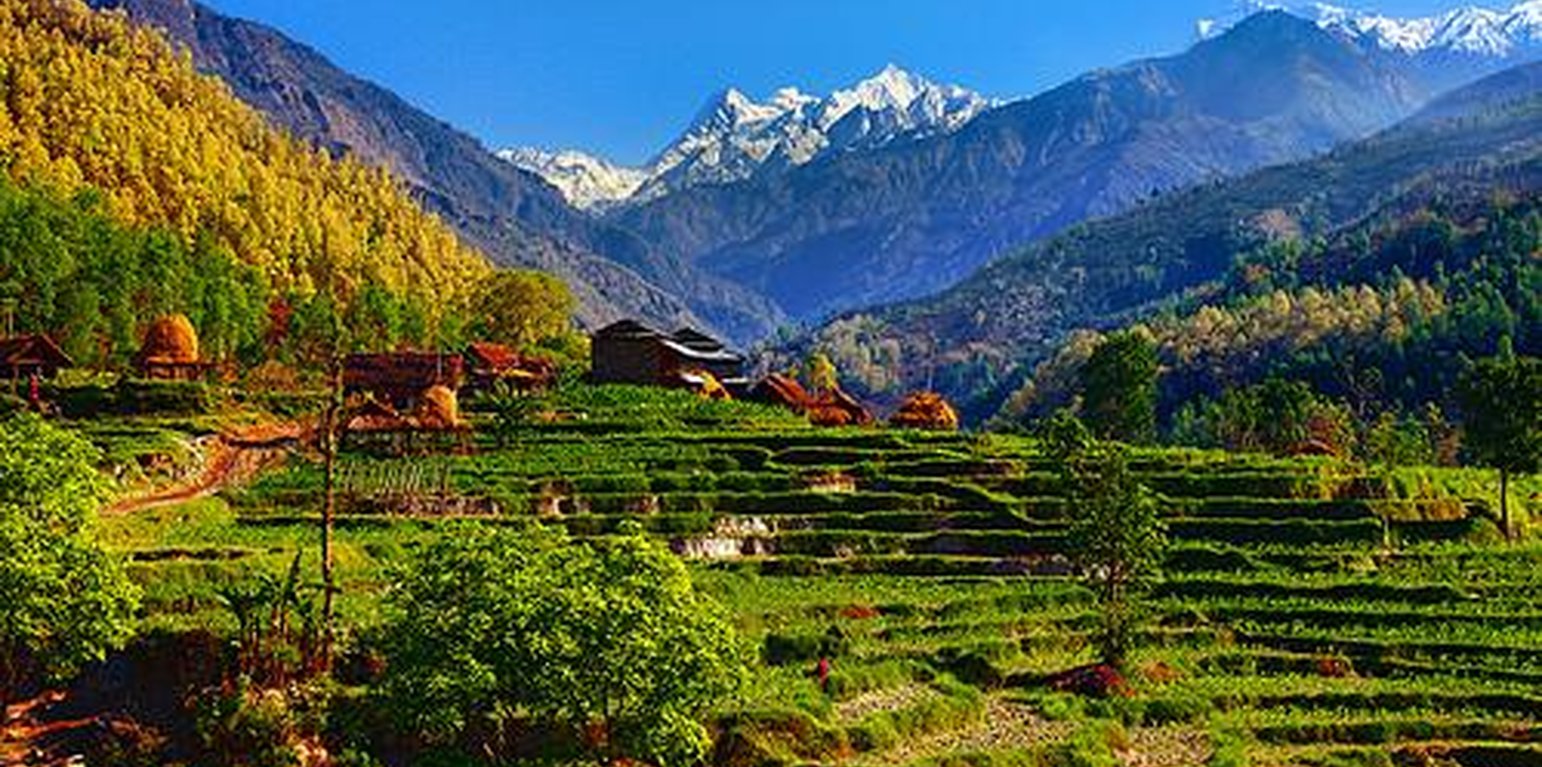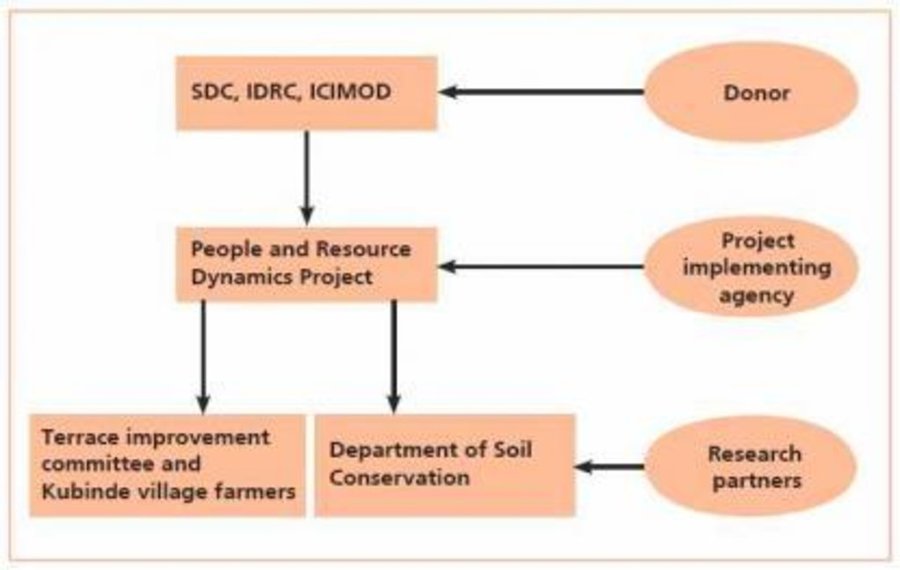Terrace Demonstration For Soil Conservation
(Nepal)
Gara Sudhar (Nepali)
Description
The slopy land used for farming process or just for land management by planting trees or grasses on those areas is terrace farming.
Aims / objectives: Main aim of terrace farming is to conserve the soil, but the system not only conserve the soil,but also help in agriculture, so it also helps people to earn their living.
Methods: Terrace farming starts from the tillaging process of the sloppy area. Usually people do not plant, productive plants on those area mainly they plant fast growing grasses and plant on those sloppy and risky areas. After some years when the mud and soil of that area get settled there properly than people also start the agriculture on those land also, from which they can earn their living.
Stages of implementation: To implement the project on that area local people had provided a lot of support. The huge economic support was provided by the European Union. Specially the Bagmati watershed management project had given huge huge economic support to this area. Mainly for water management purpose but also for land management.
Role of stakeholders: No presence of such kind of stakeholder in the project but the economic support was provided by European Union to plant trees and manage soil erosion in common land but land owner has also given their support in this project by planting trees and grasses on their land by themselves.
Other important information: Terrace farming has really helped local people to manage the land of that area, but the road making process has created a lots of problem of soil erosion which is also suppose to be managed by applying same process additional with some new process.
Location

Location: Kavre, Nepal, Nepal
Geo-reference of selected sites
Initiation date: n.a.
Year of termination: n.a.
Type of Approach
-
traditional/ indigenous
-
recent local initiative/ innovative
-
project/ programme based

-
Approach aims and enabling environment
Main aims / objectives of the approach
The Approach focused mainly on SLM with other activities (Agriculture)
1. Soil conservation.
2. Agriculture
3. For fodder, grasses etc.
The SLM Approach addressed the following problems: Low agricultural production is one of the main problem of this approach, because at initial period the soil is too loose so it may easily get lost from particular place. So, first trees were to be grown which supports the soil. Then only agriculture was to be performed. So, this is the main problem encountered by local peoples other problems were also faced by people but they were not big as the first one.
Conditions enabling the implementation of the Technology/ ies applied under the Approach
-
Legal framework (land tenure, land and water use rights): The existing land ownership, land use rights / water rights moderately helped the approach implementation: As the system helps for managing the soil and prevent different environmental calamities the land user do not create any problem while the system runs.
Conditions hindering the implementation of the Technology/ ies applied under the Approach
-
Availability/ access to financial resources and services: The financial support was provided by European union. So there was not much financial crisis.
Treatment through the SLM Approach:
-
Knowledge about SLM, access to technical support: Lack of technical knowledge had created lots of difficulties.
Treatment through the SLM Approach: Some kind of training given by technician had removed this kind of problems.
-
Workload, availability of manpower: Because of personal workload, all local people could not be present on the program on time.
Treatment through the SLM Approach: Proper schedule making for program according to local people favorable time might remove this problem.
Participation and roles of stakeholders involved
Stakeholders involved in the Approach and their roles
| What stakeholders / implementing bodies were involved in the Approach? |
Specify stakeholders |
Describe roles of stakeholders |
| local land users/ local communities |
Whoever be the land users,does not matter with sex, basically for all age group farmers, with simple living standard are aimed to be focused by stakeholders(European union). |
More male participation than female because female were busy in household works. Men particularly were more because women were mostly busy in theit home, preparing meal and performing internal task of he house. No discrimination |
| local government |
Villagers itself were implementing. |
|
| national government (planners, decision-makers) |
|
|
Involvement of local land users/ local communities in the different phases of the Approach
none
passive
external support
interactive
self-mobilization
planning
Local people and specialist
implementation
Specialist and local people
Flow chart
this information is gained from local people and approved by VDC.
Decision-making on the selection of SLM Technology
Decisions were taken by
-
land users alone (self-initiative)
-
mainly land users, supported by SLM specialists
-
all relevant actors, as part of a participatory approach
-
mainly SLM specialists, following consultation with land users
-
SLM specialists alone
-
politicians/ leaders
Decisions were made based on
-
evaluation of well-documented SLM knowledge (evidence-based decision-making)
-
research findings
-
personal experience and opinions (undocumented)
Technical support, capacity building, and knowledge management
The following activities or services have been part of the approach
-
Capacity building/ training
-
Advisory service
-
Institution strengthening (organizational development)
-
Monitoring and evaluation
-
Research
Capacity building/ training
Training was provided to the following stakeholders
-
land users
-
field staff/ advisers
Form of training
-
on-the-job
-
farmer-to-farmer
-
demonstration areas
-
public meetings
-
courses
Subjects covered
The training was given to the land users so that they also can adopt those techniques of training for conservation of their soil from erosion and other wastage.
Advisory service
Advisory service was provided
-
on land users' fields
-
at permanent centres
Name of method used for advisory service: Meeting, field visit; Local people get gather and discuss.
Advisory service is quite adequate to ensure the continuation of land conservation activities; The requirement was provided by the international supports for the project.
Institution strengthening
Institutions have been strengthened / established
-
no
-
yes, a little
-
yes, moderately
-
yes, greatly
Describe institution, roles and responsibilities, members, etc.
Type of support
-
financial
-
capacity building/ training
-
equipment
Further details
European Union provided the equipments and training for local people
Monitoring and evaluation
bio-physical aspects were regular monitored by project staff, land users through observations; indicators: erosion rate was estimated
Research
Research treated the following topics
-
sociology
-
economics / marketing
-
ecology
-
technology
The research was part of approach because research was done on local area within a society by student of KU which help to give further information of technology and approach to local people.
Research was carried out on-farm
Financing and external material support
Annual budget in USD for the SLM component
-
< 2,000
-
2,000-10,000
-
10,000-100,000
-
100,000-1,000,000
-
> 1,000,000
Precise annual budget: n.a.
Approach costs were met by the following donors: international (European Union): 95.0%; government (No support): 4.0%; international non-government (No support): 1.0%; national non-government (No support); private sector (No support); local government (district, county, municipality, village etc) (from VDC); local community / land user(s) (Local people)
The following services or incentives have been provided to land users
-
Financial/ material support provided to land users
-
Subsidies for specific inputs
-
Credit
-
Other incentives or instruments
Financial/ material support provided to land users
partly financed
fully financed
equipment: machinery: tools
Labour by land users was
-
voluntary
-
food-for-work
-
paid in cash
-
rewarded with other material support
Impact analysis and concluding statements
Impacts of the Approach
No
Yes, little
Yes, moderately
Yes, greatly
Did the Approach help land users to implement and maintain SLM Technologies?
Land management was done properly mainly from application of countering process.
Did the Approach empower socially and economically disadvantaged groups?
By utilizing the terrace land for agriculture, economically backward people were helped.
Did the Approach improve issues of land tenure/ user rights that hindered implementation of SLM Technologies?
The problem is unlikely to be overcome in the near future. No, I don't think any problem would be created in coming future if this runs smoothly
Did other land users / projects adopt the Approach?
Almost all of the land users adopted the approach.
Main motivation of land users to implement SLM
-
increased production
-
increased profit(ability), improved cost-benefit-ratio
-
reduced land degradation
-
reduced risk of disasters
-
reduced workload
-
payments/ subsidies
-
rules and regulations (fines)/ enforcement
-
prestige, social pressure/ social cohesion
-
affiliation to movement/ project/ group/ networks
-
environmental consciousness
-
customs and beliefs, morals
-
enhanced SLM knowledge and skills
-
aesthetic improvement
-
conflict mitigation
-
well-being and livelihoods improvement
Sustainability of Approach activities
Can the land users sustain what hat been implemented through the Approach (without external support)?
They can continue the task without any supports because initial support and finance from European Union was gained to established the project.
Conclusions and lessons learnt
Strengths: land user's view
-
It has controlled soil erosion (How to sustain/ enhance this strength: Can be sustain by controlling deforestation, firing in jungle, controlling over extracting of medical herbs and so on.)
-
Provide woods and other domestic products
-
Provide fodder grass etc.
Strengths: compiler’s or other key resource person’s view
-
Helps land management
(How to sustain/ enhance this strength: By handling the process from generation to generation)
-
Increase productivity by controlling soil loss (How to sustain/ enhance this strength: Awareness should be given to local people)
-
Prevent natural calamities (How to sustain/ enhance this strength: By plaining more plants soil erosion can be controlled)
-
Preserve water source (How to sustain/ enhance this strength: Afforestation program helps to preserve water source)
-
Prevent land mass and control gullies formation (How to sustain/ enhance this strength: Planting trees also helps to prevent land from gullies formation.)
Weaknesses/ disadvantages/ risks: land user's viewhow to overcome
Weaknesses/ disadvantages/ risks: compiler’s or other key resource person’s viewhow to overcome
-
Lack of technical knowledge
By providing training and skills
-
Production is less at initial phase
By adopting process continuously can increase as time passes, the plan controlled the soil loss and add nutrition to the land.
References
Date of documentation: Jan. 17, 2014
Last update: Julie 9, 2017
Resource persons
-
Sabita Aryal (sabita@ku.edu.np) - SLM specialist
-
Gangaraj Singtan - SLM specialist
-
Sabita Khanna - SLM specialist
Full description in the WOCAT database
Documentation was faciliated by
Institution
- Kathmandu University (KU) - Nepal
Project






